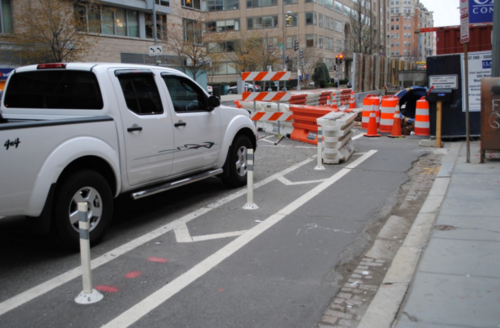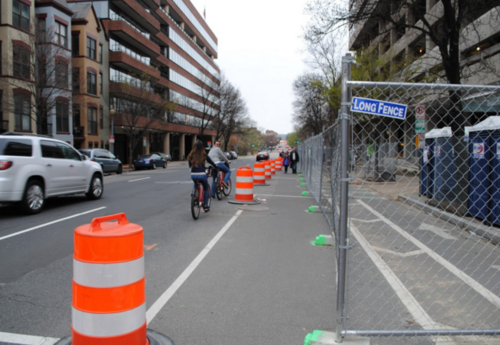In DC’s West End, construction projects are endangering cyclists and pedestrians
In DC’s West End, portions of the bikeways on L and M Streets, along with the adjacent sidewalks, are closed because of construction projects. The detours are confusing, and the result is that people on both bikes and foot are sharing narrow, unsafe spaces.

Pedestrians are supposed to use the barricaded space that’s usually a bike lane along the 2300 block of L street. There isn’t any bike space right now. All photos by the author.
On M Street, two separate segments of the sidewalk and protected bikeway are closed. The reason for closing the first segment, located along the 2200 block, is construction for a new fire station and apartments. The second segment, located along the 2500 block, is closed for a project that’s converting a former office building into luxury condominiums.
On L Street, the sidewalk and bike lane are closed along the 2300 block for construction for a new mixed-use development that will include a public library, retail, and luxury condominiums. Note that L Street’s bike lane doesn’t become a protected bikeway until one block later, east of New Hampshire Avenue.
In all three locations, physical barriers separate bike and foot traffic from car traffic.
The detours aren’t very effective As cyclists and pedestrians approach the M Street construction sites from the east, traffic signs warn that the bike lane will be shifting to the left and that the sidewalk is closing. There are instructions for pedestrians to cross to the south side of the street, where the sidewalk remains open. But with a barricaded path that seems safe right in front of them, a lot of people just proceed through it, similar to what’s currently happening at 15th and L Streets NW. Blind spots amplify this problem, with tall barriers and sharp adjustments to the barricaded path drastically limiting visibility. This is especially dangerous in the scenario where the paths of a pedestrian heading east and a cyclist heading west converge.
Tall barrier walls and sharp curves along the barricaded path on the 2300 block of M Street create dangerous blind spots for cyclists and pedestrians.

Cyclists traveling west along the 2500 block of M Street are forced to share lanes with vehicle traffic, as pedestrians walk through the space designated for bikes. Directing pedestrians to cross the street clearly is not a viable solution.

